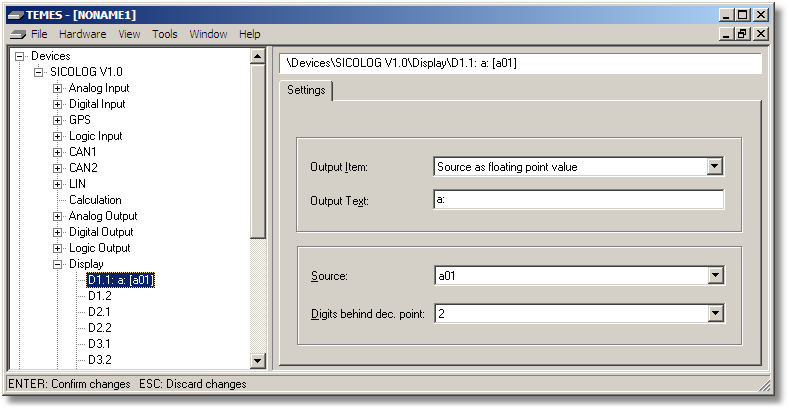TEMES 1.0

Figure 2-42: Parameter tree node Display Item.
The display items will be shown just after the start-up text disappears (or directly after a parameter set is loaded). Display items are arranged in rows and columns. The position of a display item is given by its name (Dr.c, with row r and column c). The rows beyond 4 (row ≥ 5) are shown on the second page starting with the first row. The second page can be made visible by switching the page slider from 1 to 2.
Output Item: The following types are supported.
Text – The specified Output Text will be displayed.
Source as floating point value – The first two characters of the specified output text will be displayed. Followed by the source's physical value in floating point format.
For SICOLOG/SICO3/USBDL1 V1.0.18 or better, the output text can be shorter/longer, and optionally be formatted with a ##[#...] placeholder or with a **[*...] placeholder for the floating point value, where each placeholder character represents one character of the floating point value.
Source as hex value – The first two characters of the specified output text will be displayed. Followed by the hexadecimal bit value of the source.
Source as binary value (Low-Byte) – The first two characters of the specified output text will be displayed. Followed by the binary low byte of the source's bit value.
Source as binary value (High-Byte) – The first two characters of the specified output text will be displayed. Followed by the binary high byte of the low word of the source's bit value.
CPU-Load – Displays the load of the CPU in percent. This value is temporarily insignificant for the SICOLOG/USBDL1 during USB stick I/O accesses (it will temporarily show a value of up to 100 %).
Sample rate – Displays the sample rate.
Memory usage – Displays the memory usage.
Memory block – Displays the memory block.
Date – Displays the date.
Time – Displays the time.
Bar (left) – Displays the source as bar (starting from left)
Bar (middle) – Displays the source as bar (starting from the middle)
Bar (right) – Displays the source as bar (starting from right)
Note that not all output items are necessarily implemented by the corresponding device.
Source: List of all available input signals.
Digits behind dec. point: Number of decimals.